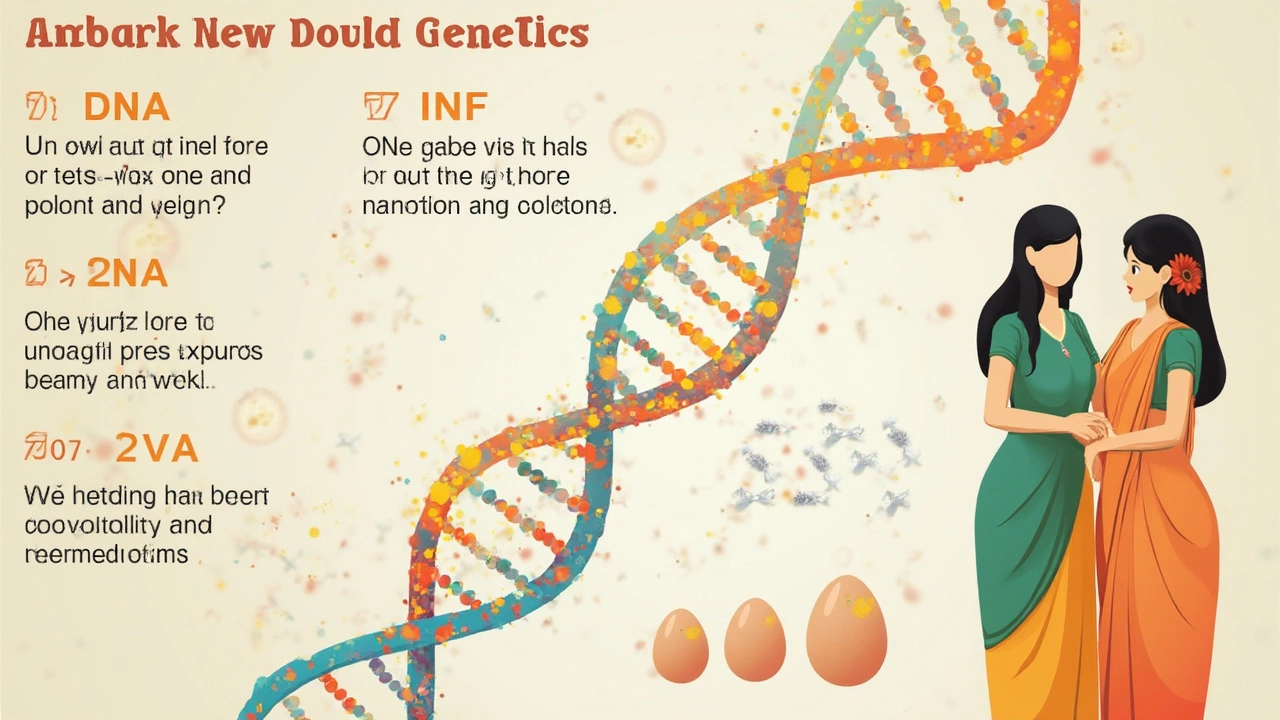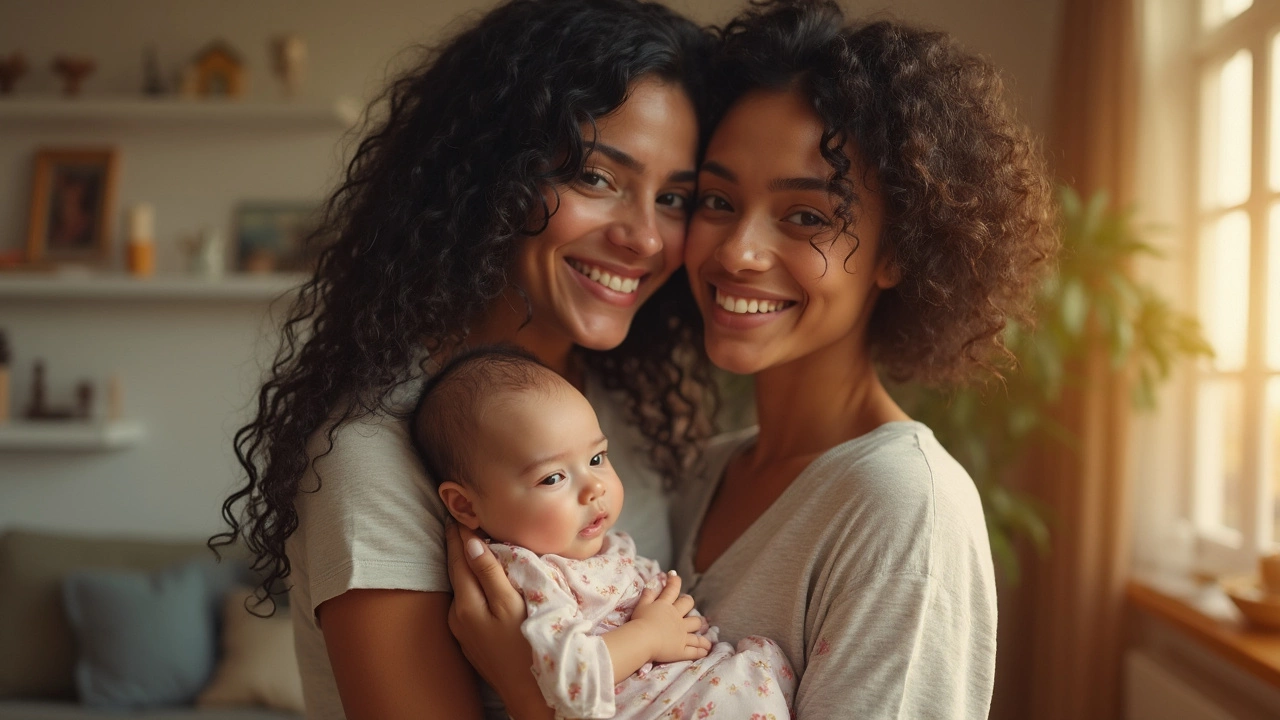If you’re thinking about having a baby through IVF, especially as a same-sex female couple, you probably want to know: will our baby look like both of us? There’s a lot of talk (and confusion) out there about DNA, sperm, eggs, and who kids actually resemble when IVF is involved. Some clinics even get asked this every single day.
Here’s the quick answer: the way an IVF baby looks depends on whose DNA is in the mix. With one mom’s egg and a donor’s sperm, your baby shares genes just with the egg provider and sperm donor. If you’re using one mom’s egg but both of you are carrying (known as reciprocal IVF), the person carrying the pregnancy doesn’t pass on DNA, but can affect the baby’s health and maybe even some tiny tweaks during pregnancy. Still, when it comes to eye color, hair, and facial features, it all boils down to genes from the egg and sperm.
If you and your partner want the child to look like you both, talk to your doctor about options like choosing a sperm donor who resembles the non-egg parent. Some families go through old photos or ask about donor details like ancestry or appearance. This helps nudge the odds in your favor. But remember, kids can surprise you—sometimes popping out with grandma’s eyes or uncle’s curly hair, just like any family.
- How Genetics Work in IVF
- IVF Options for Two Moms
- Who Does the Baby Resemble?
- Tips for Building a Family You Love
How Genetics Work in IVF
When it comes to IVF, the science is actually pretty simple once you strip away the medical jargon. The basics are this: a baby’s genes come from two sources — the egg and the sperm. In a traditional IVF setup, that could mean one mom’s egg and a sperm donor. The person whose egg is used passes on half the baby’s DNA, while the sperm donor supplies the other half.
This mix of genes decides the big stuff, like hair color, height, and eye shape. Each gene comes in pairs—one from each biological parent. That’s why so many kids are a mix of their family’s looks. Even with IVF, there’s no way to pick and choose which parent’s features show up. Sometimes the baby has the egg parent’s nose, sometimes the sperm donor’s smile.
For same-sex female couples, there’s something called reciprocal IVF. One partner’s egg is fertilized with donor sperm and the other partner carries the baby. The partner who provides the egg is the genetic mom, so the baby gets all their traits from the egg and sperm donor. The partner carrying the baby doesn't pass on DNA, but their body does shape the pregnancy experience—things like diet, stress, and overall health can make a difference in how the baby grows (just not in how the baby looks).
IVF clinics are strict about matching and testing. They screen eggs and sperm for common genetic issues, helping cut the risk of inherited diseases. Some even let you pick sperm donors based on details like hair, eye color, and height. If looks matter to you, you can use this info to choose traits similar to the non-egg mom. Still, the result isn’t guaranteed. Genes can be stubborn—you might plan for brown eyes and end up with a blue-eyed kid.
To sum up, the most important thing to remember is: only the people providing the egg and sperm pass on looks and traits. The partner who carries the pregnancy plays a huge, important role, but not in passing on physical features.
IVF Options for Two Moms
If you and your partner are both women and thinking about having a child together, there are a few main ways IVF can help make this happen. Each option works a bit differently, so it’s smart to talk through the details early, before starting the process. Clinics today see more and more same-sex female couples—this means there are now clear paths and even some flexibility, depending on your goals and needs.
The most common choice is using one mom’s eggs plus donor sperm. The baby will share DNA with the mom who provided the eggs and the sperm donor, but not the other mom. A lot of couples alternate who provides eggs if they want siblings with biological ties to both moms.
- Reciprocal IVF: Some couples want both moms involved physically. One partner gives her eggs, and the other carries the pregnancy. People love this option for the emotional connection. Still, genetics only come from the egg and sperm side.
- IVF with Egg Donor: If neither mom wants or is able to use her eggs, an egg donor is another route. Again, the child’s genes come from the donor and sperm, not either mom.
- IVF with Sperm Donor: This is always needed for female couples. Some pick a donor who looks like the non-egg parent—that way, there’s a chance for a family resemblance.
Here’s a quick look at the options and what they mean for genetics and bonding:
| Option | Egg Source | Who Carries | DNA Comes From |
|---|---|---|---|
| Traditional IVF | One Mom | Either Mom | Egg Provider & Donor Sperm |
| Reciprocal IVF | One Mom | Other Mom | Egg Provider & Donor Sperm |
| Egg Donor IVF | Donor | Either Mom | Donor Egg & Donor Sperm |
The key thing is, with any form of IVF babies, only the person who supplies the egg passes down genetic traits—things like hair, eyes, and face shape. The partner who carries the pregnancy plays a huge role in nurturing the baby, but not in the baby’s DNA. Still, carrying the pregnancy creates a different but real connection that lots of families cherish.
Planning ahead—like thinking about the sperm donor’s background, your family priorities, and how you want to split roles—can help you both feel super involved, right from day one. Some couples even freeze eggs early so they can take turns in years to come.

Who Does the Baby Resemble?
This is the question everyone asks, and for good reason. With traditional IVF, the baby gets half their DNA from the egg and half from the sperm. So, in relationships where both parents are female, only the mom who provided the egg shares her genes with the baby. The other mom, if she carries the pregnancy, does something just as important—she helps the baby grow, but doesn't pass on her DNA.
Here’s a real world example: if one mom’s eggs and a donor’s sperm are used, the baby usually looks like the egg donor parent mixed with the chosen sperm donor. Now, if you’ve heard stories about kids looking like both moms, what’s going on there? Usually, it’s just those magical mix-and-match moments that happen in any family. Shared lifestyle, even the way babies dress, can sometimes give off that resemblance vibe, but the genetics are still all about the biological providers.
Science is pretty clear: only egg and sperm carry genes that affect eye color, hair, and things like height. The idea that a gestational mom (the one who is pregnant but didn’t provide the egg) can directly pass on traits isn’t supported by evidence. What she can influence is the baby’s health, environment, and sometimes things like birth weight or even personality since the womb can change how some genes work, but not which genes the baby gets.
If seeing yourself in your child matters to you both, a lot of couples choose sperm donors who share features with the non-egg mom, such as hair texture or skin tone. Here are some tips to boost the chances your baby naturally resembles both of you:
- Use a sperm donor with physical traits similar to the non-egg mom—ask the clinic for donor photos if possible.
- Look at family health history, not just looks, for a fuller picture.
- Choose an egg provider and sperm donor with mixed ancestry if you and your partner are from different backgrounds.
The truth is, even when everything is planned, genetics loves surprises. You might see grandma’s chin or a surprise dimple. But the main thing is: if you’re using IVF babies are genetically connected to the DNA providers—egg and sperm—while the carrying mom adds plenty of love and support, even without sharing DNA.
Tips for Building a Family You Love
Building your family through IVF brings up some big decisions—especially if you want your kid to share physical traits with both moms. Here’s where to actually start making it happen, based on what real families and fertility experts recommend.
First, have open convos with your partner. Some couples value resemblance, others focus more on health or donor personality. Figure out what’s really important for both of you, and don’t be shy about discussing it with your fertility doctor.
- IVF babies can physically resemble the egg provider and sometimes the sperm donor, if that’s part of your process. Pick a sperm donor with features, ethnic background, or even talents that match the non-biological parent, if that matters to you.
- Reciprocal IVF lets one mom provide the egg and the other carry the pregnancy. While carrying doesn’t change DNA, research shows that the uterine environment can influence things like birth weight and even the child’s immune system.
- Ask your clinic about donor options. Some let you pick based on looks, health history, education, or hobbies. The more details you have, the more it feels like a fit.
- Genetics don’t guarantee anything. Siblings can look nothing alike. A baby might get curly hair from a great aunt, no matter which donor you pick.
If you want numbers to help guide your decisions, check out the table below showing a few key IVF facts:
| Fact | Details |
|---|---|
| IVF success rates in India (under 35) | About 40-45% per cycle |
| Reciprocal IVF usage (US, 2023) | About 8% of IVF cycles for same-sex female couples |
| Donors with physical feature matching | 60-70% of recipients request a resemblance to non-genetic parent |
| Genes that control basic features (e.g. eye color) | Up to 6 separate genes involved |
Don’t miss the counseling part of the process. Most clinics offer sessions—use them. You can talk through any worries about genetics, find more connection as a couple, and hear how other families have navigated the journey. I remember when Isha and I were exploring these choices, just knowing that other couples had the exact same thoughts made things less stressful.
One last tip: families are built on love, not just genes. Your child will soak up your quirks, laughs, habits, and culture, not just your DNA. Make the decisions that feel best for your partnership, and let the adventure unfold from there.
